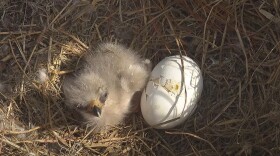A new way to mitigate the blue-green algae bloom is being tested in Southwest Florida.
The boat deploying the technology was packed with representatives from seemingly every water quality nonprofit or advocacy group in the area — along with a large pile of bright green foam.

“The product is a foam — open-cell foam — and it can have many configurations," Glenn Wattley said. "The foam that has the long fingers — when we deploy it, it looks like a curtain underwater.”
Wattley is with AquaFlex Holdings. The company started eight years ago, when founder Scott Smith created this technology to clean up the BP oil spill in the Gulf of Mexico.
This time, it wasn't petroleum but cyanobacteria that AquaFlex was after.
“This foam will collect the phosphates, which are the nutrients, so it’s kind of a two-step strategy: remove the bacteria but also remove the nutrients," Wattley said. "So, you essentially starve the bacteria as well.”
The vessel reached a particularly green canal just off the Caloosahatchee River in Fort Myers, and the captain shut off the engine. Smith, the inventor of these foam contraptions, climbed onto the stern of the boat.

“What we’re going to do here is we’re going to put in the water an open-cell foam," Smith said. "That’s designed for the whole water column.”
Smith, with the help of Sea & Shoreline’s Carter Henne, deployed the contraption in an algae-laden canal in North Fort Myers. It’ll not only allow simultaneous removal and detection of cyanobacteria but will also absorb nutrients feeding the algae bloom (nitrogen and phosphorous) pic.twitter.com/lMbNbTYUXb
— WGCU Public Media (@wgcu) August 17, 2018
“We’re removing, detecting and sampling at the same time," Smith said, "and what we’re able to do is take the top, the middle, the bottom.”
From the surface, the foam looked like a pile of inedible noodles, but below, Smith ensured it was already hard at work. The day before, the same structure deployed upriver had sucked up more than 16 times its weight in an hour.
It’s a promising way to battle the festering algae and a cost-effective one, since the sponge-like foam can be wrung out and used again. But, Charlotte Harbor National Estuary Program’s executive director says the efforts would be unnecessary if the bloom was stopped before it even had the chance to start.
“Of course, the real solution for us is really keeping nutrient pollution out of the waterways to begin with, which is the most cost-effective way of addressing this problem long-term," Jennifer Hecker said.
Hecker estimates that treatment costs at least ten times as much as prevention would. The Calusa Waterkeeper says it’s probably closer to a thousand.
Hecker spends a lot of time out on the water, and this isn’t her first bloom. But, this trip, she had to wear a respirator.
“Two weeks ago, I went out and did water quality sampling for an hour, and I was almost hospitalized for two days," Hecker said. "It’s not just people who have respiratory who have respiratory illnesses who are being exposed to these toxins that are having problems. People who don’t have any history of respiratory illness are experiencing health impacts.”
CHNEP’s executive director, Jennifer Hecker, had to wear a respirator to protect from the effects of the toxic blue-green algae this morning, following her first asthma attack in more than a decade that she says nearly led to her hospitalization last week. pic.twitter.com/EkEHjwgfms
— WGCU Public Media (@wgcu) August 17, 2018
Once all of the AquaFlex tech is deployed, Florida Gulf Coast University will begin its monitoring and testing to figure out the full scope of the bloom in Southwest Florida waters and its health effects on those with or without pre-existing conditions.








